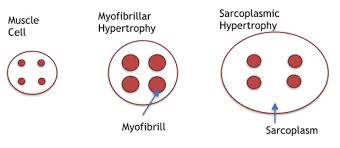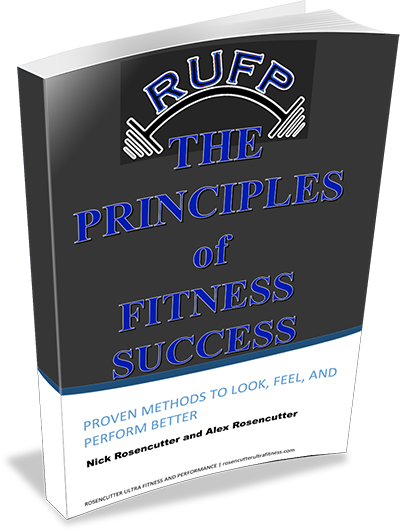By, Nick Rosencutter

If your goal is fat loss, you need to build muscle. If your goal is sports performance, you need to build muscle. If your goal is injury prevention, you need to build muscle. Muscle growth helps pretty much any endeavor people train for. Obviously not everyone is looking to or needs to build the same amount of muscle. For some people it might be supplementary to their main activity (such as a distance runner) and for others it might be the main focus of their training (such as a bodybuilder); regardless, understanding what is actually going on behind the scenes of your training can go a long way.
Hypertrophy is the scientific term for muscle growth. In its most basic sense, when we lift weights, we are tearing down muscle fibers (protein degradation) and those fibers then adapt to this trauma by growing bigger and stronger (protein synthesis). While this is the general overview of what happens, its not actually that cut and dry. A muscle fiber is made up of tiny little things called myofibrils. And those myofibrils are made up of even tinier little things called sarcomeres that consist of actin and myosin, which are contractile proteins that essentially grab onto each other and pull, in order to create a muscle contraction. Surrounding all of these myofibrils within a muscle fiber is a fluid filled space called the sarcoplasm. If we are talking about hypertrophy, we need to understand that there is more than one way that it can happen.

One extreme form of hypertrophy is called myofibrillar hypertrophy. (see picture above) Touched on in one of the greatest strength training science books of all time, “Science and Practice of Strength Training,” when this occurs, we are actually increasing the number of myofibrils within a muscle fiber, thereby increasing the density of the fiber. This is an adaptation that occurs to a greater extent in response to heavier lifting with sets in the 1 to 5 rep range. Some people falsely believe that the only way to stimulate hypertrophy is by training with moderate weights for moderate to high reps. The truth is, if you never go heavier and train in this lower rep range, you are largely missing out on an entire form of hypertrophy and you will not develop the muscle density that comes from this type of training. Furthermore, if you never use heavy enough loads to hit this rep range, you will not tap into your highest threshold motor units and their muscle fibers, since they don’t need to fire with weights lighter than this range. (motor units are a part of our nervous system that basically cause muscles fibers to do their job and different threshold units respond to different intensity levels). So both muscle fiber density and certain fibers altogether will be neglected without this type of training. These are reasons why many of the top bodybuilders throughout history have always done plenty of heavy powerlifting style lifting during their training careers. You can always tell who has put in time under a heavy bar and who hasn’t when you look at different physiques.
The other form of hypertrophy is called sarcoplasmic hypertrophy. When this occurs, the sarcoplasm between the myofibrils expands and the substrates (proteins, calcium, ions, etc.) and fluid increase. While you still get some myofibrillar action with this as well, the sarcoplasm expands at a greater rate. This is usually an adaptation that occurs to a greater extent with moderate to higher rep training with moderate to semi heavy weights (5 to 15 rep range). So while these both occur to some extent with both training modes, one is typically leaned on to a much greater extent with each loading and rep range.
Aside from these two main forms of hypertrophy, we can look at two factors playing tug of war when it comes to the stimuli that can make us grow: muscle tension and metabolic response. We create muscle tension by applying load to the muscles that we are training as they move through a high amplitude range of motion and we create a metabolic response by performing sets and reps. If we have too much load, we can’t do enough actual work to get a metabolic response and if we have too little load, we can’t create enough muscle tension to break down proteins and actually make anything adapt and grow. This is why something like distance running or doing sets of 100 with a baby weight do nothing to build muscle. There is not enough load to create any significant amount of muscle tension. You’ll get a metabolic response, but that response is primarily geared towards muscle endurance, which can actually cause those muscle fibers to adapt by getting smaller so that they can be more efficient for their endurance activity. On the other side, its also why doing nothing but heavy singles all of the time would also not do much to build a ton of muscle. There’s not enough metabolic activity to cause any growth. (although the neural adaptations would likely improve significantly) So what do we do?
It has been widely accepted for decades now that the 5-15 rep range is ideal for hypertrophy, the 1-5 rep range is ideal for maximum strength and 15-20+ is ideal for muscle endurance. This has been supported by a good amount of research, by leading organizations such as the National Strength and Conditioning Association and the National Academy of Sports Medicine, as well as in the trenches experience by thousands of lifters over many decades. After looking at the previous paragraph, its easy to see why that 5 to 15 rep range is great for hypertrophy. There is a good amount of muscle tension created via moderately heavy weights and there is a good amount of metabolic response created via that perfectly sweetened rep range. That being said, there are some gray areas here and quite a bit of crossover.
- As we already mentioned, training with 5 or less reps can go a long way in developing myofibrillar hypertrophy, stimulating our highest threshold fibers and absolutely must be a part of your training at certain times if you are trying to pack on muscle. Not only does this factor in from a straight hypertrophy sense, but if you are stronger, you can lift heavier weights for your moderate to high rep sets as well, which means more muscle growth.
- While the 5 to 15 rep range is great for general hypertrophy and should make up a bulk of training if putting on size or fat loss is the goal, going above this rep range into the 15-30 rep range can stimulate hypertrophy by giving those fibers a different stimulus, hitting different fibers and getting that extra metabolic stress that might not occur if this range is neglected.
- Different muscles can and often do respond differently to different rep ranges. Different muscles are made up of varying amounts of slow and fast twitch fibers and some muscles like different stimuli. For example, the quads and the calves both tend to respond well to higher reps at certain times. Banging out 20-50 rep sets on a leg press or 20-100 rep sets on a seated calf raise can help pack muscle onto these two while it might be a waste of time and energy for certain other muscles.
- Generally speaking, if your training always consists of nothing but super high 40-50 rep sets then you are not using enough load and there will not be enough muscle tension to give you the muscle growth that you are looking for. These high rep sets can be great for a shock to specific muscles (like mentioned above), great for recovery/blood flow work, great for some extra non taxing work to bring up a weak point, and great for muscle endurance, but should be supplementary if the goal is to build a maximum amount of muscle (regardless of what the unqualified celebrity trainer told you on TV or social media). “But I feel a great burn when I do tons of reps.” See classic high rep crunch workouts for a prime example. That burn that you feel is simply substrates such as hydrogen ions and blood lactate building up in the tissues that you are training and does not have a significant correlation to muscle hypertrophy. We need protein degradation to occur to induce hypertrophy and without enough load and, in turn, muscle tension, this will not occur enough. That being said, saturating a muscle with blood with extra high reps to finish off a workout may definitely have some benefits when used appropriately, especially once the hard and heavy work is done.
- Total volume can play a role. While 3-5 sets of 8 to 12 is great for general muscle building purposes and you can’t go wrong with it, multiple sets of lower reps can also stimulate muscle by sheer volume, i.e. 5 to 10 sets of 3 to 5. Sets and reps can be laid out in different ways, although the time under tension will be greater with the 3×8-12 in this example, which has been shown to be important for stimulating hypertrophy.
- Efficiency matters. If you are using a load that is significant enough to create adequate muscle tension to force adaptation/growth, you shouldn’t be able to do an excessive number of sets, so 3 to 5 sets of 5-15 reps is usually enough for an effective exercise, and 6 to 8 main exercises should probably be enough for one workout. If you are doing much more than this (barring small accessory/prehab exercises), you are likely not using enough load to get the adaptation you want or are just slacking off. Flashing back to number 5: if you are doing an effective high rep 15-30ish rep set, you are likely only doing a small number of sets. Beyond this, you will either be laying on your back gasping for air/bent over the toilet puking or the load and muscle tension is almost surely insignificant and you are building endurance and promoting blood flow, not much more.
Bonus note: It is the eccentric, or muscle lengthening, component of an exercise that is responsible for most of the hypertrophy improvements that you see. This means that it is the process of lowering the bar down to your chest on a bench press that does most of the damage, not the way up. Therefore, controlling that lowering phase and utilizing different tempos here can go a long way in tearing those fibers down on the way to fresh growth.
There is still plenty that is not known about hypertrophy and more studies to be done. From what is currently understood, when it comes down to it, utilizing a blend of load levels and varying rep ranges is best for optimizing hypertrophy. This is supported by both scientific and in the trenches research. We could also get into plenty of other factors such as neural components, resistance type, tempos, drop sets, rest periods etc. but we’ll save that for another article. How and when to utilize these principles discussed depends on the person and what their situation and task at hand is. This is where the art of programming/coaching and science come together. On top of all of this, if you don’t get enough calories and enough quality protein, the training you do will not matter because without the proper nutrition, your body can’t recover and grow. Now go train and make sure you’re getting enough nutrients to make it count!

1n3zgt
04nr5q